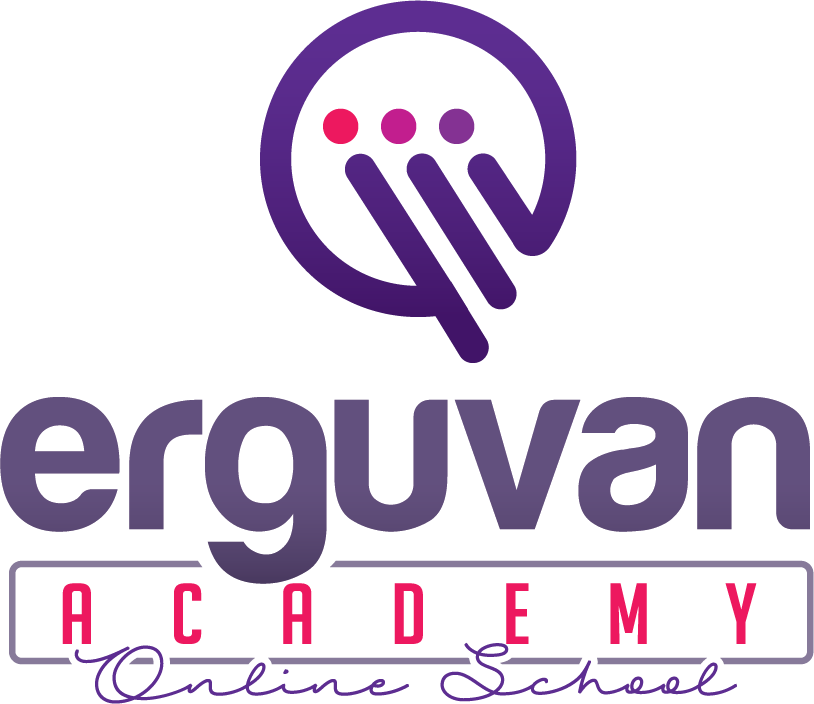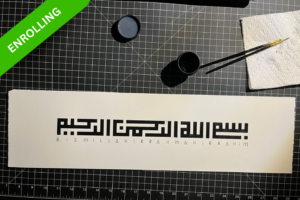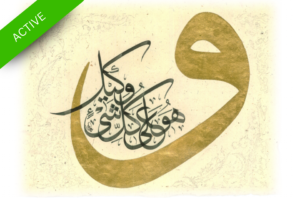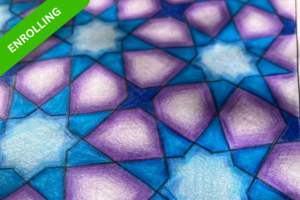Arabic Calligraphy – Thuluth (Sülüs)
Erguvan Academy’s Thuluth Certification Course is a specialized program designed to guide students into the depths of Thuluth calligraphy, mastering the art of traditional Islamic script. This program is an excellent opportunity for those who wish to learn the intricate details of Thuluth writing. The curriculum is structured to allow students to progress at their own pace, from beginner to advanced levels.
The course begins with the Rabbi Yassir prayer and gradually progresses from individual letters to words, sentences, and eventually original calligraphy pieces. Students will not only learn the fundamental techniques of Thuluth script but also explore its artistic and aesthetic aspects. Additionally, this course will equip students with the ability to integrate Thuluth calligraphy into traditional artwork, contemporary designs, and digital art.
With a flexible schedule and monthly payment plan, students can adjust their learning pace according to their needs. This course is suitable for anyone interested in calligraphy, whether for academic or artistic purposes.
Details
IMPORTANT NOTE
This class has prerequisites. Qufi Calligraphy and Islamic Geometry classes must be taken before registering for Thuluth.
Duration: Continues until achievement (~2 years)
Level: Advanced
Format: Live video lessons, downloadable practice sheets, interactive Q&A, final project
Course Start Date:
12 October 2025 – Sunday (Every Sunday for 2 Years)
Course Time (2 Hours):
9 AM PT | 12 PM EST | 6 PM CET
About the course
Erguvan Academy’s Thuluth Certification Course is a specialized program designed to guide students into the depths of Thuluth calligraphy, mastering the art of traditional Islamic script. This program is an excellent opportunity for those who wish to learn the intricate details of Thuluth writing. The curriculum is structured to allow students to progress at their own pace, from beginner to advanced levels.
The course begins with the Rabbi Yassir prayer and gradually progresses from individual letters to words, sentences, and eventually original calligraphy pieces. Students will not only learn the fundamental techniques of Thuluth script but also explore its artistic and aesthetic aspects. Additionally, this course will equip students with the ability to integrate Thuluth calligraphy into traditional artwork, contemporary designs, and digital art.
With a flexible schedule and monthly payment plan, students can adjust their learning pace according to their needs. This course is suitable for anyone interested in calligraphy, whether for academic or artistic purposes.
Key Points
In this course, you will:
- Gain an in-depth understanding of the history, aesthetics, and development of Thuluth calligraphy
- Begin with the Rabbi Yassir prayer to develop a spiritual connection to the art of calligraphy
- Master the correct writing of Arabic letters, focusing on connections, balance, and proportion
- Explore the artistic beauty of Thuluth script, including decorative techniques and ornamental letter formations
- Learn how to construct words and sentences in Arabic calligraphy with proper composition techniques
- Enhance your calligraphy with geometric embellishments and patterns for a more refined aesthetic
- Develop your own original Thuluth piece, receive detailed feedback, and learn techniques necessary for certification
- Create a calligraphy artwork as your final project, incorporating all the techniques learned throughout the course
- Gain the ability to apply Thuluth calligraphy in digital design and artwork
Required Materials
1. Papers:
- Calligraphy Paper: Soft-textured paper, ideal for calligraphy practice. Specialized calligraphy papers are recommended.
- Textured Thick Papers: Provides a professional look for finished calligraphy pieces.
- Large-Format Reusable Papers: Essential for practicing large letters and compositions.
2. Pens & Writing Tools:
- Reed Pen (Qalam): The traditional pen used for Thuluth calligraphy (available in fine, medium, and broad tips).
- Felt-Tip Calligraphy Markers: Useful for modern applications and advanced practice.
- Graphite Pencil: Necessary for sketching and initial outlines.
3. Ink & Oil-Based Ink:
- Traditional Calligraphy Ink: Black or dark inks are preferred, though other colors may be used.
- Oil-Based Ink: Commonly used for traditional Thuluth writing.
4. Measuring Tools:
- Metal Ruler: Ensures straight and precise lines.
- Protractor: Helps create accurate angles.
- Grid Ruler: Useful for maintaining proper proportions and spacing.
5. Compasses & Circular Drawing Tools:
- Compass: Essential for drawing arcs and circles.
- Circle Templates: Helps create geometric elements and balanced calligraphy.
6. Brushes & Supporting Tools:
- Fine & Broad Brushes: Used for ink detailing and final touches.
- Ink Sponge: Helps regulate ink flow.
7. Colored Inks & Paints (Optional):
- Gold Leaf: Commonly used for Islamic calligraphy embellishments.
- Colored Inks: Used for both writing and decorative elements.
8. Digital Tools (Optional):
- Digital Calligraphy Tablet (Procreate/Adobe Illustrator): For students who wish to explore Thuluth calligraphy in a digital medium.
- Graphic Design Software (Photoshop, Illustrator): Useful for creating digital calligraphy compositions.
9. Fine Brushes (Optional):
- Small brushes for detailed decorations, miniature calligraphy work, and final refinements.
10. Alternative Tools:
- Ballpoint & Graphite Pencils for advanced sketching and calligraphy preparation.
Note: This materials list may vary depending on individual student preferences. While traditional Thuluth calligraphy primarily relies on reed pens, ink, and paper, digital materials are recommended for those interested in modern applications.
Course Lessons
Students begin with the fundamental principles of Thuluth calligraphy and letter formations. The Rabbi Yassir prayer serves as an entry point, fostering mental and spiritual preparation.
- Weeks 1-4: Writing the Rabbi Yassir prayer, correct posture, pen grip, and basic strokes.
- Weeks 5-8: Learning basic letters and introductory exercises.
- Weeks 9-12: Writing the first set of letters and simple word formations.
Students focus on individual Arabic letters and their connections. Practical lessons are provided with detailed feedback.
- Weeks 13-16: Alif, Ba, Ta, Tha (basic Arabic letters).
- Weeks 17-20: Jeem, Ha, Kha, Dal, Dhal (intermediate letter formations).
- Weeks 21-24: Mastering letter connections and word formations.
At this stage, students combine letters into words, developing the rhythm of Thuluth script.
- Weeks 25-28: Advanced letter formations and joined letter applications.
- Weeks 29-32: Writing full words and simple sentences.
Weeks 33-36: Integrating geometric ornamentation into calligraphy.
Students refine their technique, focusing on the aesthetic beauty of Thuluth script with geometric and decorative elements.
- Weeks 37-40: Advanced letter formations and artistic refinements.
- Weeks 41-44: Islamic decorative motifs and stylistic variations.
- Weeks 45-48: Ensuring visual harmony and balance in compositions.
In the final phase, students develop a personal Thuluth piece, applying all learned techniques into an original work.
- Weeks 49-52: Individual mentorship for final project development.
- Weeks 53-56: Completion of final projects for certification.
- Weeks 57-60: Presentation of final pieces and feedback.
Learning Process & Evaluation
Monthly Feedback: Students submit their work at the end of each month for personalized critiques.
Hands-On Practice: Guided exercises for mastering calligraphy techniques and aesthetics.
Original Artwork: Students create their own pieces, developing their unique style.
Instructors

Ali Karatay
Ali Karatay, an artist with 20+ years of experience in visual arts, a Ph.D. in Islamic Arts, and a traditional icazet (calligraphy masery certification), will be teaching alongside master calligrapher (hattat) Yusuf Zakir.
Features
- Live lessons available as recordings
- 1 month access after course ends
- Google Classroom
- Certificate of completion
Related courses
Qufi Calligraphy
LEARN Instructed by Ali Karatay 12 Weeks 2+ Hrs Live Classes/Week Beginner Level Language: Turkish Fill out our INTEREST FORM for English classes. ENROLL NOW...
Visit Course PageArabic Calligraphy – Thuluth (Sülüs)
Erguvan Academy’s Thuluth Certification Course is a specialized program designed to guide students into the depths of Thuluth calligraphy, mastering the art of traditional Islamic...
Visit Course PageIslamic Geometric Art
LEARN Instructed by Ali Karatay 12 Weeks 2+ Hrs Live Classes/Week Beginner Level Language: Turkish Fill out our INTEREST FORM for English classes. ENROLL NOW...
Visit Course Page